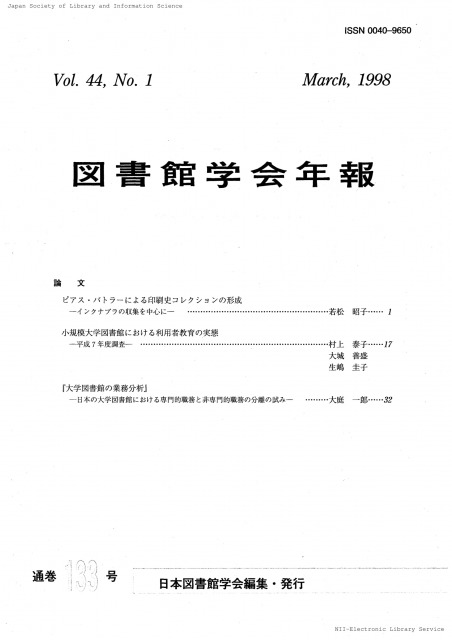24 巻, 2 号
選択された号の論文の14件中1~14を表示しています
- |<
- <
- 1
- >
- >|
論文
-
原稿種別: 論文
1978 年 24 巻 2 号 p. 49-57
発行日: 1978年
公開日: 2022/10/07
PDF形式でダウンロード (1197K) -
原稿種別: 論文
1978 年 24 巻 2 号 p. 58-72
発行日: 1978年
公開日: 2022/10/07
PDF形式でダウンロード (1607K) -
原稿種別: 論文
1978 年 24 巻 2 号 p. 73-80
発行日: 1978年
公開日: 2022/10/07
PDF形式でダウンロード (1050K) -
原稿種別: 論文
1978 年 24 巻 2 号 p. 81-88
発行日: 1978年
公開日: 2022/10/07
PDF形式でダウンロード (1037K) -
原稿種別: 論文
1978 年 24 巻 2 号 p. 89-96
発行日: 1978年
公開日: 2022/10/07
PDF形式でダウンロード (922K)
研究ノート
-
原稿種別: 研究ノート
1978 年 24 巻 2 号 p. 97-101
発行日: 1978年
公開日: 2022/10/07
PDF形式でダウンロード (639K) -
原稿種別: 研究ノート
1978 年 24 巻 2 号 p. 102-105
発行日: 1978年
公開日: 2022/10/07
PDF形式でダウンロード (473K)
文献展望
-
原稿種別: 文献展望
1978 年 24 巻 2 号 p. 106-108
発行日: 1978年
公開日: 2022/10/07
PDF形式でダウンロード (439K) -
原稿種別: 文献展望
1978 年 24 巻 2 号 p. 108-112
発行日: 1978年
公開日: 2022/10/07
PDF形式でダウンロード (745K)
アゴラ
-
原稿種別: アゴラ
1978 年 24 巻 2 号 p. 72,80,96
発行日: 1978年
公開日: 2022/10/07
PDF形式でダウンロード (360K) -
原稿種別: アゴラ
1978 年 24 巻 2 号 p. 96
発行日: 1978年
公開日: 2022/10/07
PDF形式でダウンロード (130K) -
原稿種別: アゴラ
1978 年 24 巻 2 号 p. 105,112
発行日: 1978年
公開日: 2022/10/07
PDF形式でダウンロード (254K)
書評
-
原稿種別: 書評
1978 年 24 巻 2 号 p. 101,105
発行日: 1978年
公開日: 2022/10/07
PDF形式でダウンロード (251K)
学会消息
-
原稿種別: 学会消息
1978 年 24 巻 2 号 p. 57
発行日: 1978年
公開日: 2022/10/07
PDF形式でダウンロード (99K)
- |<
- <
- 1
- >
- >|
